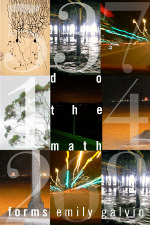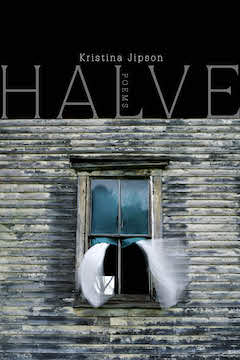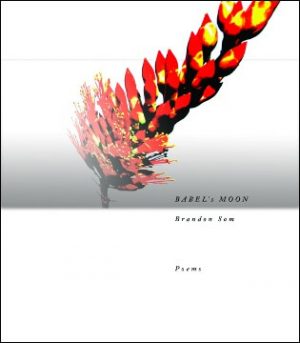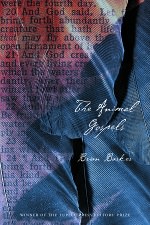Do the Math: Forms
by Emily Galvin
$19.95
“Emily Galvin is actually trying to be formulaic with a mashup of poetry and numbers in Do the Math), an effort which plays considerably better than it should. Poems and spoken exchanges of dialogue are based on the intervals inherent in fractals, the Fibonacci sequence, the Golden Ratio, and so on, counting by lines, words, syllables, or spaces. Galvin gets around the problem of mechanical over-regimentation by allowing speakers to loan or borrow the odd word through interruptions. The central problem is the approximation of communication—how our notions can almost converge without ever aligning completely. These pieces reflect thinking which is too nuanced to dismiss as pure novelty.
— Todd Mercer, ForeWord Magazine
Format: paperback
See Katie Manning’s review of Do the Math in the Spring 2010 issue of the online Boxcar Poetry Review.
[T]he whole book appears to be an invitation to slow down and think. Galvin attends to the language as well as to the math of these poems, making them enjoyable and thought-provoking on both levels. Do the Math will reward multiple readings, and it is absolutely worth the time to read it closely.
Emily Galvin is actually trying to be formulaic with a mashup of poetry and numbers in Do the Math (Tupelo Press, 2008), an effort which plays considerably better than it should. Poems and spoken exchanges of dialogue are based on the intervals inherent in fractals, the Fibonacci sequence, the Golden Ratio, and so on, counting by lines, words, syllables, or spaces. Galvin gets around the problem of mechanical over-regimentation by allowing speakers to loan or borrow the odd word through interruptions. The central problem is the approximation of communication—how our notions can almost converge without ever aligning completely. These pieces reflect thinking which is too nuanced to dismiss as pure novelty.
— Todd Mercer, ForeWord Magazine (July-August, 2008)
Click here to view the full piece.
Emily Galvin, as much a mathematician as poet, explores the connection between poetry and science by using the Fibonacci sequence and other mathematical formulas to create undeniably compelling and imaginative poems and short lyrical plays. But no mere math exercises, these poems brim with emotional insight and extraordinary wit. A significant community of readers, writers, and bloggers are treading the crossroads where math and poetry intersect and creating something entirely new and viscerally affecting. Emily Galvin is one of the heralds of this new movement with this dazzling collection in which science does not limit art, but enriches it.
Additional information
| Weight | .4 lbs |
|---|---|
| Dimensions | 6 × .5 × 9 in |
Light Warning
No.
Wait
for it.
You know how
The air feels after everything
Has been carried out, doors and windows closed?
Deep wintertime—I felt the cold coming through the glass, the old blade loose
In my left hand. Late at night I used to sit against the window at the far end of my bed
And hope like hell that something would break through. The intimacy of drywall, cold air leaking through. I watched the glass sink through itself inside the window-frame. Sore ribs. I kept on staring through,
As if only waiting. Wheels in the ditch. Body on the wall. Red sky all night that time of year. Where I live now, it never gets that cold. Sometimes, though, when the fires get close enough to let a little ash into the air, I think of windowpanes, and sparks fly out my mouth.
Note: A Fibonacci poem: The number of words in each line increases in a Fibonacci sequence.
Ω = Ωm + ΩΛ
DO THE MATH
excerpt
ΩΛ
In the corner of the room, the heater starts up, howling. The joints vibrate and scream. After a minute, the sound diminishes to a whisper, as though passing out or just getting used to it. Outside, the trees are greener now that the sun is gone behind the clouds, and the water has reached the same shade as the sky, two bars of metal cutting the green.
ΩΛ
Three, two, one: the friction kicks in. Inertia keeps things in, all but friction. But in general, there’s no need to stop, we can go on forever and even increase. Ω = 1: we could go on forever. But nothing’s slowing down. Everything just keeps on in acceleration, and even the love of our collective life, this little bit of earth and light in transit round a star, remains as distances increase, the things we haven’t thought of run away.






